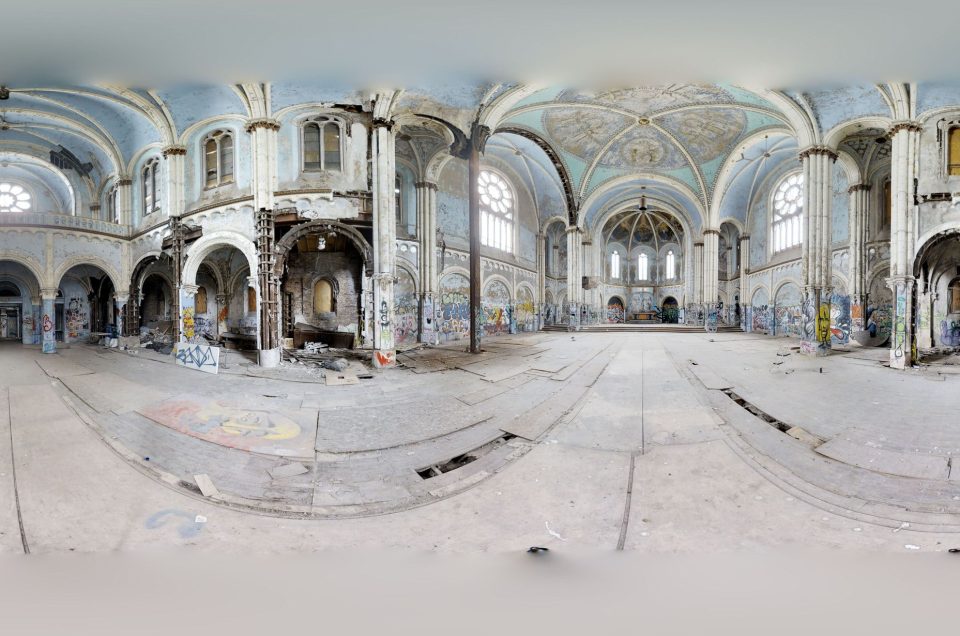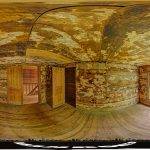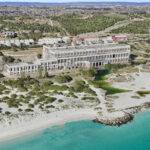Space Launch Complex 34
Discover the intriguing history and captivating remnants of Launch Complex 34 at Cape Canaveral Space Force Station with our 360-degree panoramic virtual tour. Located along Florida’s picturesque east coast, this once-vital aerospace facility now stands as a fascinating destination for urban explorers. Dive into the abandoned site’s rich past by viewing all nine immersive panoramic images below, each offering a unique perspective of the complex. If urban exploring piques your interest, we’ve also provided a detailed map packed with GPS locations, ensuring you have plenty of exciting spots to visit and explore. Join us in uncovering the hidden stories of Launch Complex 34 and embark on your next adventure today!
Click here to view it in fullscreen.
Here is an 8K 360VR video of the historic launch pad.
The Construction and Legacy of Launch Complex 34
The construction of Launch Complex 34 began on June 8th, 1959, initially intended for a missile named Juno V. This project was overseen by the Army Ballistic Missile Agency (ABMA). However, later that year, the missile was renamed Saturn, and the entire program was transferred to the National Aeronautics and Space Administration (NASA). On August 11th, 1960, the final inspection of the blockhouse, a critical component of the launch complex, was completed.
Design and Specifications of Launch Complex 34
The blockhouse of Launch Complex 34 is a robust structure located approximately 1,000 feet away from the launch pad. It is designed to withstand the intense conditions associated with rocket launches. The blockhouse measures 120 feet in diameter, stands 30 feet high, and has walls that are between 5 to 7 feet thick. These dimensions were critical for ensuring the safety of personnel and equipment during launches.
The launch pad itself is a substantial piece of engineering. It consists of a reinforced concrete pad that is 430 feet in diameter and 8 inches thick, providing a solid foundation for the massive rockets. The launch pedestal, a key feature of the pad, measures 42 feet square and stands 27 feet tall. It includes a 26-foot exhaust opening to channel the rocket’s exhaust gases away from the launch site, minimizing damage and ensuring a successful launch.
Early Operations and Modifications
By February 1961, Launch Complex 34 was operational and ready for service. One of the notable early events was the movement of the $4,000,000 service tower on its tracks for the first time on March 26th, 1961. This tower was essential for providing access to the rocket for servicing and pre-launch preparations.
Between 1963 and 1965, the complex underwent modifications to support the Saturn IB rocket, a more advanced version of the original Saturn I. These modifications were necessary to accommodate the increased size and power of the new rockets. From October 1961 through October 1968, Launch Complex 34 saw a total of seven launches: four Saturn I launches and three Saturn IB launches. These missions were crucial in testing the capabilities of the rockets and gathering data for future space missions.
The Tragic Apollo 1 Fire
One of the most significant and tragic events in the history of Launch Complex 34 occurred on January 27th, 1967. At 1831 hours, a flash fire broke out in the capsule during a pre-launch test, killing astronauts Virgil “Gus” Grissom, Edward H. White II, and Roger B. Chaffee. This tragedy, known as the Apollo 1 fire, was a pivotal moment in the history of space exploration. It led to a complete review and overhaul of safety procedures and protocols within NASA.
Following the Apollo 1 tragedy, the complex continued to play a role in the Apollo program. On October 11th, 1968, the first manned Saturn IB Apollo launch, Apollo 7, was successfully launched from Launch Complex 34. This mission was notable as it was the only manned Apollo mission to take place at the Cape Canaveral Air Force Station. All subsequent Apollo missions were launched from Kennedy Space Center’s Pads 39A and 39B.
The Standby and Deactivation of Launch Complex 34
By 1968, Launch Complex 34 was placed in standby status, with the possibility of being used for the Skylab program. However, this did not come to fruition. On January 1, 1969, the complex was officially deactivated, and by November 1971, it was mothballed. In April 1972, the service structure was scrapped, marking the end of its operational life.
The cost of constructing Launch Complex 34 was $6,216,000, but by 1966, the total expenditure had grown to $25,340,000. This increase reflected the various modifications and enhancements made to the complex to support different rocket configurations and missions.
The Legacy of Launch Complex 34
Although Launch Complex 34 is no longer operational, its legacy lives on. The complex played a crucial role in the early days of America’s space program, supporting some of the first heavy-lift rockets designed for human space exploration. The lessons learned and the data gathered from the launches at LC-34 were invaluable in the development of later space missions, including the Apollo missions that ultimately landed humans on the Moon.
The site of Launch Complex 34 is now a somber memorial to the Apollo 1 astronauts. A plaque commemorates their sacrifice, and the remains of the launch pedestal stand as a silent reminder of the dangers and challenges of space exploration. The site is often visited by space enthusiasts and historians who wish to pay their respects and reflect on the history of human spaceflight.
The Design and Construction of Launch Complex 34
The construction of Launch Complex 34 required extensive planning and engineering. The initial phase involved selecting a suitable site at Cape Canaveral Air Force Station, considering factors such as proximity to the ocean for safety, distance from populated areas, and the ability to accommodate the large structures needed for rocket launches.
The blockhouse, a critical component of the complex, was designed to provide a safe environment for personnel controlling the launches. Its thick walls and robust construction were necessary to withstand the intense vibrations and potential explosions associated with rocket launches. The blockhouse housed the control room, instrumentation, and communication systems, all essential for managing the complex operations of a rocket launch.
The launch pad itself was another engineering marvel. The reinforced concrete pad had to support the enormous weight of the rockets and withstand the extreme temperatures and forces generated during launches. The launch pedestal, with its exhaust opening, was designed to channel the rocket’s exhaust gases away from the launch area, preventing damage to the pad and surrounding structures.
Early Challenges and Solutions
The early days of Launch Complex 34 were not without challenges. Engineers and construction crews faced numerous obstacles, from the technical difficulties of building such massive structures to the logistical challenges of transporting materials and equipment to the site.
One of the significant challenges was ensuring the stability and durability of the launch pad and pedestal. The intense heat and force generated by rocket launches required materials and construction techniques that could withstand these extreme conditions. Engineers used reinforced concrete and advanced construction methods to ensure the pad’s longevity and resilience.
Another challenge was the integration of the complex’s various systems, including the blockhouse, service tower, and launch pad. These systems had to work seamlessly together to support the complex operations of rocket launches. This required meticulous planning, coordination, and testing to ensure that all components functioned correctly and reliably.
Modifications and Upgrades
As the space program evolved, so too did Launch Complex 34. The modifications made between 1963 and 1965 to support the Saturn IB rocket were significant. These upgrades included reinforcing the launch pad, enhancing the blockhouse’s instrumentation and control systems, and upgrading the service tower to accommodate the larger and more powerful Saturn IB rockets.
These modifications were essential for supporting the more ambitious goals of the Apollo program. The Saturn IB rocket was a critical component of the program, serving as a testbed for the technologies and systems that would eventually be used in the Saturn V rocket, which carried astronauts to the Moon.
The Human Element
While the engineering and technical aspects of Launch Complex 34 are impressive, the human element is equally important. The complex was a hub of activity, with engineers, technicians, and support staff working tirelessly to prepare for each launch. The dedication and hard work of these individuals were crucial to the success of the missions launched from LC-34.
The tragedy of Apollo 1 highlighted the risks and dangers inherent in space exploration. The loss of Grissom, White, and Chaffee was a profound blow to the space community, but it also served as a catalyst for significant changes in safety protocols and procedures. The lessons learned from this tragedy were instrumental in making subsequent missions safer and more successful.
The End of an Era
The deactivation and eventual dismantling of Launch Complex 34 marked the end of an era. However, its legacy continues to inspire and inform current and future space exploration efforts. The complex’s contributions to the early days of the space program are a testament to the ingenuity, dedication, and perseverance of the people who worked there.
Today, the site of Launch Complex 34 stands as a historical landmark, reminding us of the challenges and triumphs of the early days of space exploration. It serves as a poignant reminder of the sacrifices made and the progress achieved in the quest to explore the final frontier.
Conclusion
Launch Complex 34 was more than just a collection of buildings and equipment; it was a critical part of the foundation of America’s space program. From its construction in the late 1950s to its deactivation in the early 1970s, LC-34 played a vital role in advancing human spaceflight. The complex supported some of the earliest and most significant missions, including the Apollo 7 launch and the ill-fated Apollo 1 mission.
The history of Launch Complex 34 is a story of innovation, perseverance, and resilience. It is a story of engineers and scientists pushing the boundaries of what was possible and of astronauts bravely venturing into the unknown. It is a story that continues to inspire new generations of space enthusiasts and explorers.
As we look to the future of space exploration, the lessons learned and the achievements made at Launch Complex 34 will continue to guide and inspire us. The complex’s legacy is a testament to the power of human ingenuity and the enduring spirit of exploration.
You can learn more about the historical launch complex on the Air Force Space & Missile Museum website. View more abandoned launch pads such as launch complex 14, launch complex 17 or launch complex 16 that were photographed in 360-degree spherical imagery. You can also check out our top abandoned places in Florida page.
Do you have 360-degree panoramic images captured in an abandoned location? Send your images to Abandonedin360@gmail.com. If you choose to go out and do some urban exploring in your town, here are some safety tips before you head out on your adventure.
Equipment used to capture the 360-degree panoramic images:
- Canon DSLR camera
- Canon 8-15mm fisheye
- Manfrotto tripod
- Custom rotating tripod head
If you want to start shooting 360-degree panoramic images, you might want to look onto one-click 360-degree action cameras.
Click on a state below and explore the top abandoned places for urban exploring in that state.







4 Comments
[…] Museum website. View more abandoned launch pads such as launch complex 14, launch complex 17 or launch complex 34 that were photographed in 360-degree spherical […]
[…] Force Space and Missile Museums website. View more abandoned launch pads such as launch complex 17, launch complex 34 or launch complex 16 that were photographed in 360-degree spherical […]
[…] by a company called Moon Express. View more abandoned launch pads such as launch complex 14, launch complex 34 or launch complex 16 that were photographed in 360-degree spherical […]
[…] aerostat balloon radar missions site. View more abandoned launch pads such as launch complex 17, launch complex 34 or launch complex 16 that were photographed in 360-degree spherical […]